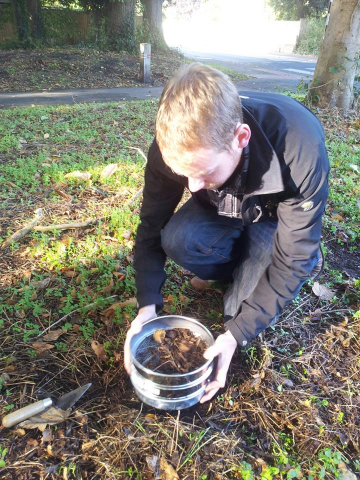CGO Ecology has teamed up with Bournemouth University to carry out a research project into the occurrence and possible impacts of a tiny invertebrate animal from the southern hemisphere. The Australian landhopper (Arcitalitrus dorrieni) is an amphipod crustacean, in the same family (Talitridae) as our freshwater shrimps. They live in leaf litter, usually beneath trees.
Landhoppers are a mere 10mm long, and since being accidentally introduced to the Isles of Scilly some time prior to 1924, have been spreading quietly across Britain for almost a century. They have become widespread around the coast of southwest Britain, with a scattering of Scottish and Irish records too. However, the true distribution is likely to be much greater than published data suggest, particularly in coastal areas. Winter freezing seems to be a limiting factor inland.

Research by CGO Ecology in autumn 2012 showed that Australian landhoppers are widespread in the Bournemouth area of Dorset. The map here shows red dots where A. dorrieni was found, and green dots where it was not found when surveyed.
Now in autumn 2013, with the help of Bournemouth University student Jack Rawlings (studying BSc Ecology & Conservation in the School of Applied Sciences), we are carrying out a more detailed research project.
The chief aim is to determine whether Australian landhoppers may be having an impact on native leaf litter and soil fauna such as springtails. Landhoppers tend to exist at very high densities, and can consume a high proportion of leaf litter. This could theoretically be deleterious to other native detritivores sharing the same habitat.
A simple detection methodology for landhoppers was developed by CGO Ecology last year, involving 10 kick-scrapes of leaf litter in a localised area. If landhoppers are present, they are usually evident immediately, as soon as litter is disturbed; and almost certainly within 10 scrapes. The adults are bigger than springtails, and more vigorous jumpers, continuing to jump around for longer than springtails before they are able to find purchase and re-bury themselves. 
For his BSc dissertation research, Jack will be sampling a range of sites in autumn 2013, with and without landhoppers, and attempting to quantify the numbers and/or biomass of alien vs native detritivores. He will collect leaf litter samples, sieve them and process them to remove the fauna.
The aim is to see whether there is any variability in native detritivore abundance and distribution, and if so, whether this might correlate with landhopper distribution and abundance.
In the meantime, we would be very happy to receive any reports of landhoppers in the Bournemouth, Dorset and New Forest area. Elsewhere in the country, the British Myriapod and Isopod Group is welcoming records.
If you want to have a go at searching for Australian landhoppers yourself, why not a have a little kick around. Just find an area of dead leaves lying over soil, either in your garden or some local woodland, and use your foot to scrape back some leaf litter. If landhoppers are present, you should see them, glistening dark grey to black, and jumping about vigorously for a couple of seconds.
To the uninitiated, our native springtails look similar, but they are usually paler and smaller, no more than 5mm long, and they tend to jump only once or twice before disappearing under dead leaves again. Landhoppers usually take three or four jumps before finding refuge.

